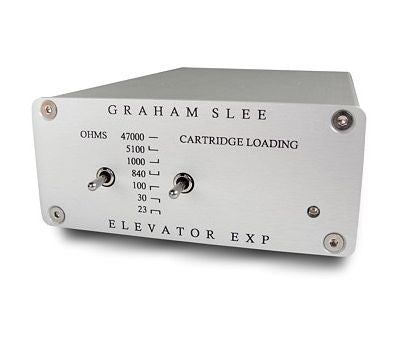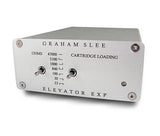Description:
Moving Coil Step up "Transformer Less": Elevator EXP MC Head Amp
Please note: Due to the large volume of orders currently your order that would normally take 2 weeks to be dispatched, could be delayed and lead times of up to 4 weeks can be expected currently.
The Elevator EXP does just what its name suggests: it elevates the tiny signal from conventional moving coil cartridges to moving magnet level, and at the same time gives it the EXPress Elevator treatment!
Ships in approximately 3 weeks.
Best for MC!
 (the case styling changed in 2004)
(the case styling changed in 2004)
Hi-Fi News 2005 award winner!
Along with the Era Gold V, our Elevator EXP thrilled Hi-Fi News to make us their 2005 award winner (click here for bigger image)
Stereophile AAA Rated!
[Michael Fremer, Analog Corner, Stereophile, September 2007]
EnjoyTheMusic.com's "Joe Audiophile" puts it this way...
[Scott Faller, "Vinylly Yours Virtually", EnjoyTheMusic.com, February 2010]
This Ultra Linear Treatment Is A Must Have!
Owners of our moving magnet sensitivity phono stage preamps and owners of valve (tube) phono stage preamps will need this step-up device between turntable and phono stage preamp to use a moving coil phono cartridge.
It provides 22dB of gain (amplification) which is approximately 13 times the output of the moving coil cartridge. Therefore for example, if you use a 0.4mV output moving coil cartridge it will deliver just over 5mV to your moving magnet sensitivity phono stage preamp. With a gain of 13 it can deal with cartridges of between 0.15mV and 0.8mV with ease, delivering the required input range required by our phono stage preamps and many others.

The graph shows the Elevator EXP is flat to nearly 1Mhz, and is stable, having 86 degrees of phase margin where it's gain reaches unity at just over 10MHz. The Elevator EXP is truly a wideband step-up amplifier, its stability ensuring it will not tune a radio station or other radio interference.
As for hum, it is not a transformer, it is not inductive, so it can't pick up any hum. The case is fully shielded and tested for ground continuity, so provided the interconnects to and from it are shielded, it won't amplify any other interference. It's power supply input is effectively filtered to remove interference too.
As with any other true-to-the-source amplifier stage handling such delicate signals, it cannot put source problems right, and success therefore depends on ensuring cartridge, and tone-arm signal and "earth" wiring is serviceable.
The Elevator EXP provides a choice of another six load resistances on its easily understood front panel switch matrix in addition to the standard 100 Ohm moving coil loading. Keen eyed technical observers will note a further two positions are possible on the matrix, these deliver 90 Ohms (left down/right up) and 29 Ohms (left up/right down) which are so close to other values as to be arbitrary - still they may be of use.
A Warning About Cables
Several manufacturers of interconnect cables are now selling "floating shield", "knitted" and otherwise unshielded "audiophile" cables. Some are quite misleading suggesting that they are shielded but the description can go on to say that the shield is electrically isolated which means it may as well not exist at all - it simply doesn't shield a thing unless it is connected (both ends) and being isolated means it isn't connected.
These may be OK for large line level signals, and you may believe you are successfully employing some of them between a CD player and suchlike and your amplifier. However, they WILL cause great amounts of hum and radio pick-up when used for low level signals such as the output from the Elevator EXP on its way to the phono stage.
Just 1mV of interference landing on the conductors of one of these interconnects is right down near the noise floor compared with a large 1 volt or more CD player output (minus 60dB or better). BUT the output from the Elevator EXP to your phono stage is only a few mV, usually around 5mV, so the interference is a staggering 20% of the signal. In dB terms that's minus 14dB of noise - that's a terrible spec., and all you'll hear is loud hum. If these "audiophile" cables are supplied as a pair (two separate cables - one for left - one for right) there is every possibility that the interference in one channel will be different to the interference in the other - airborne interference (electromagnetic disturbance) is never consistent.
It is a little understood but scientifically true fact that there are many feedback routes (some intentional, some perhaps not) in a phono stage because they are by their very nature, extremely high gain devices (1,000 times or more at low frequencies for a MM stage). If you use one of these "audiophile" cables between your phono stage and amplifier, any interference landing on it can permeate back to the phono stage input, and then you will have lots of interference on your signal just the same.
Just because the advertising blurb for such cables is so compelling and has been regurgitated over and over by the hi-fi press means nothing scientifically. Parts of the hi-fi press are so uneducated regarding the science they are writing about that it is shocking. Also there are some dealers who consider hi-fi as being a "gravy train". They may also be either uneducated regarding the science, or if they are educated then that makes matters worse because they know they're deceiving you. There is a process of brainwashing taking place and it is very hard for manufacturers to help the customer where the customer is stubbornly convinced that someone who solders wires together is somehow superior to someone who understands electronics at a much deeper level.
Specification
Input range: 0.15mV to 0.8mV
Output (for input range): 2mV to 10mV
Maximum input: 378mV rms
Maximum output: 4.914V rms
Gain: 22dB (13) 0.1Hz to 917kHz (-3dB points)
Input impedance: 23, 30, 100, 840, 1000, 5100 and 47000 Ohms
Output (driving/source) impedance: 300 Ohm
Recommended load impedance: 47k Ohms phono stage preamp input
Noise at output: -99dB CCIR Q-pk
Distortion: 0.02%
Frequency response: 0.1Hz to 917kHz (-3dB points)
Channel balance: 0.2dB
Channel separation: 64dB
Size: (approx.) W: 107 x H: 50 x D: 180 (mm) inc. jacks



